St. Mary’s University Student Develops AI-Driven Data to Extend Drone Flight Times

A computer engineering student at St. Mary’s University is leveraging artificial intelligence to create data that teaches drones to mimic bird-like flight patterns, potentially revolutionizing extended missions like search and rescue by addressing power limitations. Joshua Riojas, 22, draws on machine learning to help unmanned aerial vehicles (UAVs) stay aloft longer using natural air currents.
Discovering the Drone Lab
Riojas first encountered the Unmanned Aerial Systems Lab during a self-guided tour of the San Antonio campus a few years ago, reports the San Antonio Report. The lab, established in 2021, integrates drone research into the university’s Science, Engineering and Technology curriculum. This chance sighting ignited his interest, leading him to pursue work there as a computer engineering major.
Addressing Power Constraints in UAVs
Drones often face short flight durations due to battery issues, limiting their use in prolonged operations such as post-flood surveys in areas like Kerr County.
“I’m pretty sure you have seen on social media, ‘Why wouldn’t they deploy drones for search and rescue missions?’” Riojas said. “And the simple answer is that they can’t last long in the air due to power issues.”
Engineers recognize sailplanes as a viable model, since these aircraft harness wind to maintain flight without constant energy expenditure. Riojas focuses on training drones to detect and utilize air patterns similarly. This approach could enhance operational efficiency for professional drone operators conducting long-range inspections or recreational pilots exploring extended aerial photography.
Building Machine Learning Models
Riojas generates data by analyzing air currents’ direction and velocity, then correlating them with drone responses like stability in specific positions. He equips drones with motion capture markers and directs them to follow a ground vehicle fitted with a fan, recording movements including precise locations within rising air.
The models interpret drone orientation metrics—roll, pitch, and yaw—to determine optimal positioning.
“If that drone is at the very center of that rising air, then it’ll tell you that it’s at the center. But if it’s at the edge of it, then it’ll tell you because it’s going to be looking at the roll, pitch and yaw,” Riojas said.
Ben Abbott, the engineering lecturer supervising the project, emphasizes the goal:
“He is trying to create a machine learning — in this age of AI that we’re in — that can become as smart as the bird, smarter than humans.”
This hands-on method highlights trends in AI integration for UAVs, where algorithms process subtle environmental data to optimize flight paths. Such advancements raise questions about scalability, as accurate models could reduce energy consumption and extend missions economically.
Securing Funding for Autonomous Research
In October 2024, St. Mary’s obtained a U.S. Department of Defense grant exceeding $340,000 to acquire autonomous vehicles, including drones and ground units.
“This grant enables us to do research on autonomous vehicles, AI and overall security,” said Wenbin Luo, Ph.D., professor of computer engineering at St. Mary’s. “In addition, we also want to use it as a teaching platform, so we can use what we learn and pass the knowledge on to our students.”
While the funding primarily supports cybersecurity against cyberattacks on unmanned systems, it opens doors for diverse projects like Riojas’. The Department of Defense allocated over $5 billion for grants in fiscal year 2025, awarding more than 2,000 new ones, underscoring national investment in such technologies.
Implications for Drone Applications
Building on that, the research aims to inform UAV designs for sustained flight, benefiting search and rescue where endurance is critical. Abbott views AI as essential in education, providing students practical experience to solve real-world challenges.
“Well, what we’re learning here … is how to use the AI,” Abbott said. “I mean, Joshua, he doesn’t know it yet, but he can compete with anyone.”
This development signals broader trends in drone technology, where AI enhances safety and efficiency without regulatory overhauls yet. For professionals, it promises cost savings through reduced battery dependency; for enthusiasts, it offers longer recreational flights. As UAVs grow smarter, this student-led initiative demonstrates how academic research drives practical innovations in the field.
Featured photo courtesy of: B. Young / San Antonio Report.
Discover more from DroneXL.co
Subscribe to get the latest posts sent to your email.
Check out our Classic Line of T-Shirts, Polos, Hoodies and more in our new store today!

MAKE YOUR VOICE HEARD
Proposed legislation threatens your ability to use drones for fun, work, and safety. The Drone Advocacy Alliance is fighting to ensure your voice is heard in these critical policy discussions.Join us and tell your elected officials to protect your right to fly.
Get your Part 107 Certificate
Pass the Part 107 test and take to the skies with the Pilot Institute. We have helped thousands of people become airplane and commercial drone pilots. Our courses are designed by industry experts to help you pass FAA tests and achieve your dreams.

Copyright © DroneXL.co 2025. All rights reserved. The content, images, and intellectual property on this website are protected by copyright law. Reproduction or distribution of any material without prior written permission from DroneXL.co is strictly prohibited. For permissions and inquiries, please contact us first. DroneXL.co is a proud partner of the Drone Advocacy Alliance. Be sure to check out DroneXL's sister site, EVXL.co, for all the latest news on electric vehicles.
FTC: DroneXL.co is an Amazon Associate and uses affiliate links that can generate income from qualifying purchases. We do not sell, share, rent out, or spam your email.


















